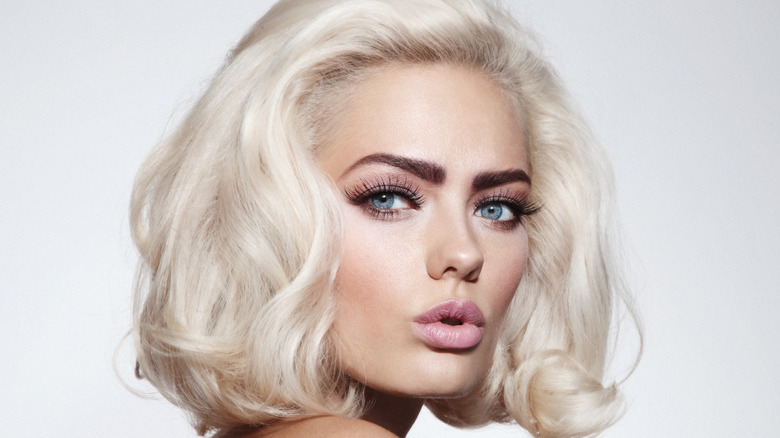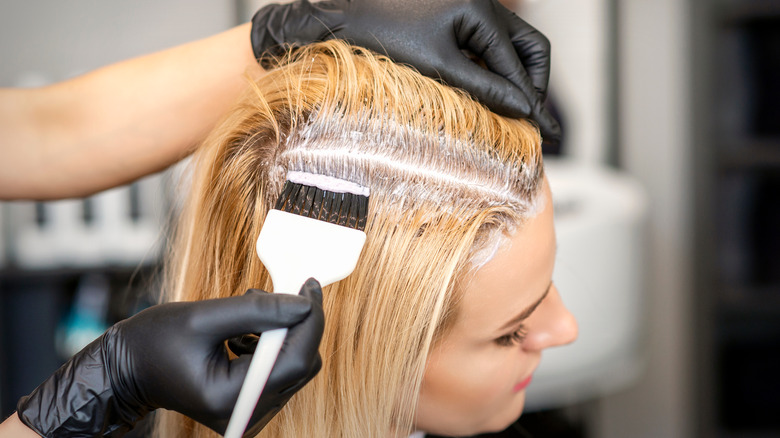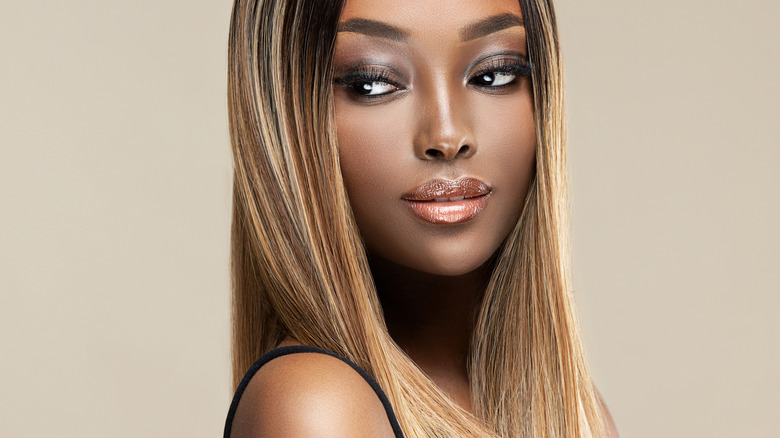How To Tell If Your Hair Is Healthy Enough To Bleach It Blond
Choosing to bleach your hair blond is not a decision to make lightly. Though many of us have struggled with the temptation to rock platinum tresses, the impact of the process on your hair is definitely something you'll want to consider before reaching for the bleach. Hair brand Redken highlights several things to think carefully about before booking an appointment to dye your hair blond. For one, you'll likely need to adjust your post-bleach haircare routine to include hydrating products and purple shampoo, which can be costly. The brand also points out that your natural hair color plays a part in what tone of blond is achievable for you within a certain time frame, and your skin tone can affect how warm or cool blonds will complement you.
As bleach can result in weaker, dryer hair, it's also important to make sure that your hair is healthy enough to bleach. While going blond should be a transition that you discuss with your stylist well in advance, there are also some things you can do at home to find out how healthy your hair is.
Why and how to determine your hair health
It's vital that your hair is in a healthy state before you bleach it blond. Why? Because bleach, overall, is not so great for your hair. Naturally Curly explains that bleach, a chemical, reacts with the melanin in hair in an oxidization process that permanently removes the color. Over-exposure to bleach can have a drying effect on the hair which weakens the strands and makes them prone to breakage (via John Frieda). So if you apply bleach to hair that's already weak, dry, or brittle, you may end up with hair damage.
To determine the health of your hair at home, one of the easiest methods is the water test detailed by Madison Reed. Simply take a strand of your hair and pull it so it's straight. Add a drop of water to it and time how quickly your hair absorbs the water. If the process takes less than 10 seconds, it's a sign of damaged hair that isn't ready to be bleached. Additionally, the hair specialists at Botox Capilar advise asking yourself a few questions about your hair to get an idea of how healthy it is. Is your hair always dull and rough to the touch? Do you lose a lot of hair through washing or brushing? Do you have split ends or low-porosity hair? If you answered yes to any of these questions, it's likely that your hair is not healthy enough to proceed with bleaching. The good news is that there are steps you can take to improve your hair health and get your locks ready to undergo the bleaching process.
How to repair your hair
The American Academy of Dermatology Association has several tips for improving your hair health. The basics include using conditioner after every wash and washing more frequently if you have oily hair. You can also obtain healthier hair by using products that are specifically designed for your hair type, such as shampoo for dry hair, and by defending your tresses with protective products prior to swimming in chlorinated water. Similarly, you should use a heat protectant before heat-styling with a blow dryer, curler, or flat iron (via Garnier). As a rule of thumb, also be gentle when combing your hair — Healthline outright suggests not brushing your hair at all when it's wet. However, if your ends are split or damaged already, these tips will only get you so far, and you may need to trim them off to prevent more breakage.
Once you do bleach your hair, it's critical to keep up your haircare routine and give your locks some extra TLC. To reduce the damage from bleach, be sure to incorporate regular bond-repairing and deep-conditioning treatments into your schedule (via Philip Kingsley). These strengthen the existing bonds of your hair and add shine and hydration. It can also help to apply a lightweight serum to your hair to seal your cuticles and protect your hair from environmental factors such as pollution and UV rays.
If you do want to bleach your hair, healthy and strong locks are a must. Conduct these DIY tests to determine whether your hair fits the bill, or whether you need to do a little repair work before visiting the salon.


